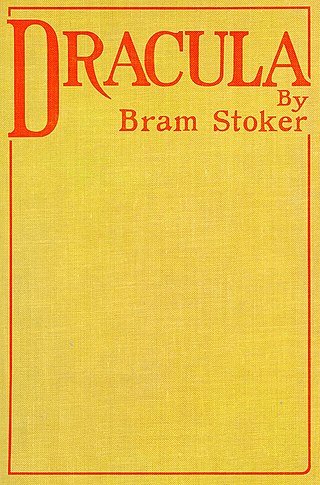
Dracula is a novel by Bram Stoker, published in 1897. An epistolary novel, the narrative is related through letters, diary entries, and newspaper articles. It has no single protagonist and opens with solicitor Jonathan Harker taking a business trip to stay at the castle of a Transylvanian nobleman, Count Dracula. Harker escapes the castle after discovering that Dracula is a vampire, and the Count moves to England and plagues the seaside town of Whitby. A small group, led by Abraham Van Helsing, investigate, hunt and kill Dracula.

Vampire literature covers the spectrum of literary work concerned principally with the subject of vampires. The literary vampire first appeared in 18th-century poetry, before becoming one of the stock figures of gothic fiction with the publication of Polidori's The Vampyre (1819), which was inspired by the life and legend of Lord Byron. Later influential works include the penny dreadful Varney the Vampire (1847); Sheridan Le Fanu's tale of a lesbian vampire, Carmilla (1872), and the most well known: Bram Stoker's Dracula (1897). Some authors created a more "sympathetic vampire", with Varney being the first, and more recent examples such as Moto Hagio's series The Poe Clan (1972-1976) and Anne Rice's novel Interview with the Vampire (1976) proving influential.

Kim James Newman is an English journalist, film critic and fiction writer. He is interested in film history and horror fiction—both of which he attributes to seeing Tod Browning's Dracula at the age of eleven—and alternative history. He has won the Bram Stoker Award, the International Horror Guild Award and the BSFA award.

The Anno Dracula series by Kim Newman—named after Anno Dracula, the series' first novel—is a work of fantasy depicting an alternate history in which the heroes of Bram Stoker's novel Dracula fail to stop Count Dracula's conquest of Britain, resulting in a world where vampires are common and increasingly dominant in society. While Dracula is a central figure in the events of the series, he is a minor character in the books and usually appears in only a few climactic pages of each book. While many of the characters from Newman's Diogenes Club stories appear in the Anno Dracula novels, they are not the same as the ones in those stories, nor is the Diogenes Club itself the same.

Bram Stoker's Dracula is a 1992 American vampire horror film produced and directed by Francis Ford Coppola and written by James V. Hart, based on the 1897 novel Dracula by Bram Stoker. The film stars Gary Oldman, Winona Ryder, Anthony Hopkins, Keanu Reeves, Richard E. Grant, Cary Elwes, Billy Campbell, Sadie Frost, and Tom Waits. Set in 19th century England and Romania, it follows the titular vampire (Oldman), who falls in love with Mina Murray (Ryder), the fiancée of his solicitor Jonathan Harker (Reeves). When Dracula begins terrorizing Mina's friends, Professor Abraham Van Helsing (Hopkins), an expert in vampirism, is summoned to bring an end to the vampire's reign of terror. Its closing credits theme "Love Song for a Vampire", is written and performed by Annie Lennox.
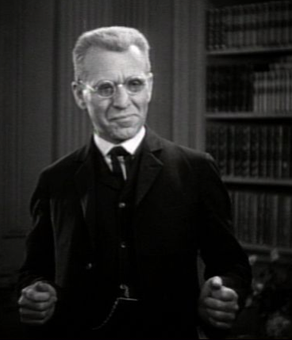
Professor Abraham Van Helsing is a fictional character from the 1897 gothic horror novel Dracula written by Bram Stoker. Van Helsing is a Dutch polymath doctor with a wide range of interests and accomplishments, partly attested by the string of letters that follows his name: "MD, D.Ph., D.Litt., etc.", indicating a wealth of experience, education and expertise. He is a doctor, professor, lawyer, philosopher, scientist, and metaphysic. The character is best known through many adaptations of the story as a vampire slayer, monster hunter and the arch-nemesis of Count Dracula, and the prototypical and the archetypical parapsychologist in subsequent works of paranormal fiction.

R. M. Renfield is a fictional character who appears in Bram Stoker's 1897 Gothic horror novel Dracula. He is Count Dracula's deranged, fanatically devoted servant and familiar, helping him in his plan to turn Mina Harker into a vampire in return for a continuous supply of insects to consume and the promise of immortality. Throughout the novel, he resides in an asylum, where he is treated by Dr. John Seward.

Wilhelmina "Mina" Harker is a fictional character and the main female character in Bram Stoker's 1897 Gothic horror novel Dracula.

Quincey P. Morris is a fictional character in Bram Stoker's 1897 gothic novel Dracula.

Vampire films have been a staple in world cinema since the era of silent films, so much so that the depiction of vampires in popular culture is strongly based upon their depiction in films throughout the years. The most popular cinematic adaptation of vampire fiction has been from Bram Stoker's 1897 novel Dracula, with over 170 versions to date. Running a distant second are adaptations of the 1872 novel Carmilla by Sheridan Le Fanu. By 2005, the Dracula character had been the subject of more films than any other fictional character except Sherlock Holmes.

The Brides of Dracula are fictional characters in Bram Stoker's 1897 novel Dracula. They are three seductive vampire "sisters" who reside with Count Dracula in his castle in Transylvania, where they entice men with their beauty and charm, and then proceed to feed upon them. Dracula provides them with victims to devour, mainly implied to be infants.

Jonathan Harker is a fictional character and one of the main protagonists of Bram Stoker's 1897 Gothic horror novel Dracula. An English solicitor, his journey to Transylvania and encounter with the vampire Count Dracula and his Brides at Castle Dracula constitutes the dramatic opening scenes in the novel and most of the film adaptations.

John "Jack" Seward, M.D. is a fictional character appearing in Bram Stoker's 1897 novel Dracula.
Dracula is an 1897 novel by Bram Stoker.
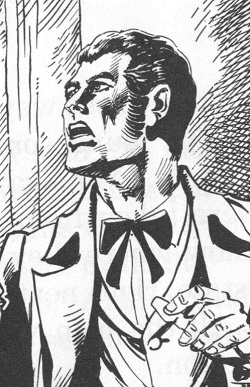
Arthur "Art" Holmwood is a fictional character in Bram Stoker's 1897 novel Dracula.
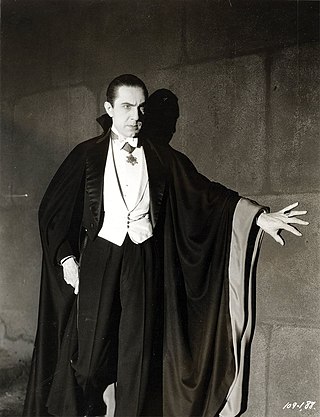
Count Dracula is the title character of Bram Stoker's 1897 gothic horror novel Dracula. He is considered the prototypical and archetypal vampire in subsequent works of fiction. Aspects of the character are believed by some to have been inspired by the 15th-century Wallachian prince Vlad the Impaler, who was also known as Vlad Dracula, and by Sir Henry Irving, an actor for whom Stoker was a personal assistant.

Dracula, also known as Bram Stoker's Dracula and Dan Curtis' Dracula, is a 1974 British made-for-television gothic horror film and adaptation of Bram Stoker's 1897 novel Dracula. It was written by Richard Matheson and directed by Dark Shadows creator Dan Curtis, with Jack Palance in the title role. It was the second collaboration for Curtis and Palance after the 1968 TV film The Strange Case of Dr. Jekyll and Mr. Hyde.
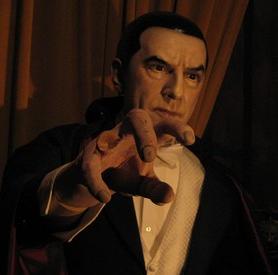
The character of Count Dracula from the 1897 novel Dracula by Bram Stoker, has remained popular over the years, and many forms of media have adopted the character in various forms. In their book Dracula in Visual Media, authors John Edgar Browning and Caroline Joan S. Picart declared that no other horror character or vampire has been emulated more times than Count Dracula. Most variations of Dracula across film, comics, television and documentaries predominantly explore the character of Dracula as he was first portrayed in film, with only a few adapting Stoker's original narrative more closely. These including borrowing the look of Count Dracula in both the Universal's series of Dracula and Hammer's series of Dracula, including include the characters clothing, mannerisms, physical features hair style and his motivations such as wanting to be in a home away from Europe.

Anno Dracula is a 1992 novel by British writer Kim Newman, the first in the Anno Dracula series. It is an alternate history using 19th-century English historical settings and personalities, along with characters from popular fiction.
School for Vampires is a 2006 horror-comedy animated television series, based on the children's book Die Schule der kleinen Vampire by Jackie Niebisch in 1983.

















